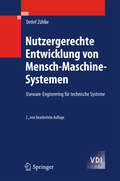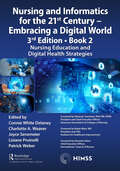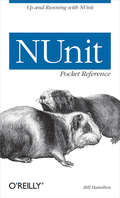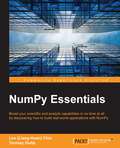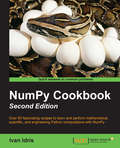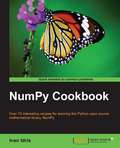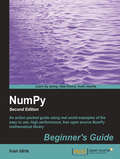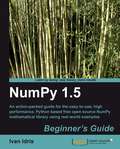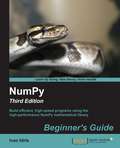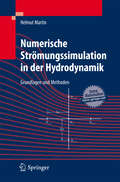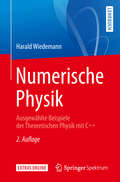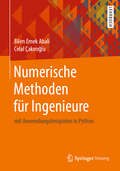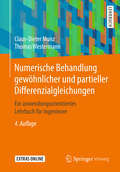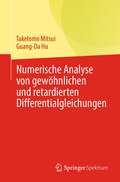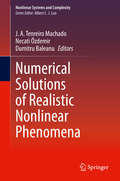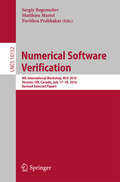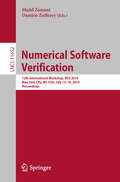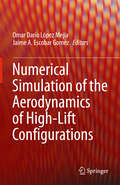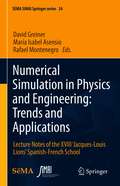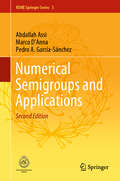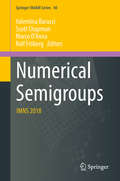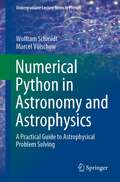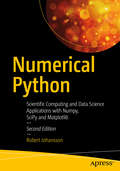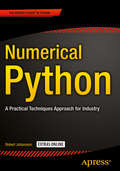- Table View
- List View
Nutzergerechte Entwicklung von Mensch-Maschine-Systemen
by Detlef ZühlkeDas Buch gibt Entwicklern einen Leitfaden zur nutzergerechten Gestaltung von Mensch-Maschine-Systemen an die Hand. Dabei werden die besonderen Gestaltungsprobleme von Useware-Systemen für internationale Märkte ebenso behandelt wie die Auswahl von Entwicklungstools, Normen und Richtlinien sowie grundlegende Gestaltungsregeln. Wichtige Neuerungen, etwa die modellbasierte Entwicklung von Benutzungsschnittstellen oder zukünftige Interaktionsformen, werden in der Neuauflage anhand von Gestaltungsbeispielen vorgestellt.
Nursing and Informatics for the 21st Century - Embracing a Digital World, 3rd Edition - Book 2: Nursing Education and Digital Health Strategies (HIMSS Book Series)
by Connie White DelaneyNursing Education and Digital Health Strategies explores the current state of health and healthcare education, as well as that of nursing informatics education. These topics include technologies-enabled education for all nurses and interprofessional collaborations from a worldwide perspective. The "New" learning for applied critical thinking will include technology, content, skills versus tools, and the use of "smart" systems for care delivery, the role of critical thinking, and uniqueness of nursing care delivery. Further, how these changes are understood as a paradigm shift that needs to be incorporated along with nursing and healthcare education is emphasized. The effects of technology on human behavior are also explored, addressing human–factors interaction, interdependence of human–computer interaction, and other effects of technology on wellbeing. As part of nursing education, learning from clients/patients to better shape and advance nursing education and scholarship are discussed. Academic–clinical practice partnerships for a digital future, how teams are working together (clinician/teacher) for better healthcare delivery and applied knowledge—including joint appointments (exchange of academia and applied expertise), academic–applied human resources, and interprofessional learning/development—are discussed. This book closes by discussing and using case studies to showcase nursing competencies for the next decade, implications for preparing the healthcare workforce for a digital world, faculty readiness, and the interaction with gaming and simulations. Nursing informatics education, including continuing education beyond academia, i.e., informal education, worldwide, as well as global challenges to support digital world capabilities are described. Hands-on Experiential Delivery and learning-based case studies are also included. Nursing and Informatics for the 21st Century – Embracing a Digital World, 3rd Edition is comprised of four books which can be purchased individually: Book 1: Realizing Digital Health – Bold Challenges and Opportunities for Nursing Book 2: Nursing Education and Digital Health Strategies Book 3: Innovation, Technology, and Applied Informatics for Nurses Book 4: Nursing in an Integrated Digital World that Supports People, Systems, and the Planet
Nur the Vlogger Fairy (Rainbow Magic #1154)
by Daisy MeadowsNur the Vlogger Fairy is planning Fairyland's biggest vlogger meet-up ever - Magic Vlog Con! But jealous Jack Frost wants to become a vlogging superstar and has stolen Nur's magical objects. Without them, vloggers can't make fun videos. Nur needs Rachel, Kirsty, Gracie and Khadijah's help to get her enchanted objects back and show Jack Frost that vlogging is for expressing yourself, not becoming famous. Can the fairy friends find Nur's lucky ring light, her cool camera and her magic microphone and save Magic Vlog Con? 'These stories are magic; they turn children into readers!' ReadingZone.comIf you like Rainbow Magic, check out Daisy Meadows' other series: Magic Animal Friends and Unicorn Magic!
NUnit Pocket Reference
by Bill HamiltonFew .NET developers have the luxury of unlimited code testing once their application is complete, and rushing through the testing process is both problematic and stressful. The open source NUnit framework provides an excellent and efficient way to test and improve .NET code as it's written, saving hundreds of QA hours and headaches. NUnit is one of the most mature and widely-used .NET open source projects even Microsoft uses it internally. NUnit is a unit-testing framework for all .Net languages. Written entirely in C#, NUnit takes advantage of many .NET language features, such as custom attributes and other reflection related capabilities. It automates unit testing and reduces the effort required to frequently test code while developing it. NUint is invaluable for .NET developers in test-driven development under agile methodologies such as Extreme Programming (XP) as well as for developers who use for unit testing for software quality assurance. Unfortunately, some of those valuable hours saved by using NUnit can be wasted trying to master this powerful but under-documented framework Proof that good things come in small packages, the NUnit Pocket Reference is a complete reference to NUnit, filling in the blanks left by the existing documentation and online discussion. It offers developers everything they need to know to install, configure, and use NUnit; the NUnit user interface; and a reference to the NUnit framework classes in a slim but well-organized package. This handy little book even offers practical, real world NUnit examples. And with the NUnit Pocket Reference, IT managers will know to expect when they implement unit testing in their projects. It is the only book you'll need on this popular and practical new open source framework.
NumPy Essentials
by Tanmay Dutta Leo Liang-Huan ChinBoost your scientific and analytic capabilities in no time at all by discovering how to build real-world applications with NumPy About This Book * Optimize your Python scripts with powerful NumPy modules * Explore the vast opportunities to build outstanding scientific/ analytical modules by yourself * Packed with rich examples to help you master NumPy arrays and universal functions Who This Book Is For If you are an experienced Python developer who intends to drive your numerical and scientific applications with NumPy, this book is for you. Prior experience or knowledge of working with the Python language is required. What You Will Learn * Manipulate the key attributes and universal functions of NumPy * Utilize matrix and mathematical computation using linear algebra modules * Implement regression and curve fitting for models * Perform time frequency / spectral density analysis using the Fourier Transform modules * Collate with the distutils and setuptools modules used by other Python libraries * Establish Cython with NumPy arrays * Write extension modules for NumPy code using the C API * Build sophisticated data structures using NumPy array with libraries such as Panda and Scikits In Detail In today's world of science and technology, it's all about speed and flexibility. When it comes to scientific computing, NumPy tops the list. NumPy gives you both the speed and high productivity you need. This book will walk you through NumPy using clear, step-by-step examples and just the right amount of theory. We will guide you through wider applications of NumPy in scientific computing and will then focus on the fundamentals of NumPy, including array objects, functions, and matrices, each of them explained with practical examples. You will then learn about different NumPy modules while performing mathematical operations such as calculating the Fourier Transform; solving linear systems of equations, interpolation, extrapolation, regression, and curve fitting; and evaluating integrals and derivatives. We will also introduce you to using Cython with NumPy arrays and writing extension modules for NumPy code using the C API. This book will give you exposure to the vast NumPy library and help you build efficient, high-speed programs using a wide range of mathematical features. Style and approach This quick guide will help you get to grips with the nitty-gritties of NumPy using with practical programming examples. Each topic is explained in both theoretical and practical ways with hands-on examples providing you efficient way of learning and adequate knowledge to support your professional work.
NumPy Cookbook - Second Edition
by Ivan IdrisIf you are a Python developer with some experience of working on scientific, mathematical, and statistical applications and want to gain an expert understanding of NumPy programming in relation to science, math, and finance using practical recipes, then this book is for you.
NumPy Cookbook
by Ivan IdrisWritten in Cookbook style, the code examples will take your Numpy skills to the next level. This book will take Python developers with basic Numpy skills to the next level through some practical recipes.
NumPy Beginner's Guide (Second Edition)
by Ivan IdrisThe book is written in beginner's guide style with each aspect of NumPy demonstrated with real world examples and required screenshots.If you are a programmer, scientist, or engineer who has basic Python knowledge and would like to be able to do numerical computations with Python, this book is for you. No prior knowledge of NumPy is required.
NumPy 1.5 Beginner's Guide
by Ivan IdrisThe book is written in beginner's guide style with each aspect of NumPy demonstrated by real world examples. There is appropriate explained code with the required screenshots thrown in for the novice. This book is for the programmer, scientist or engineer, who has basic Python knowledge and would like to be able to do numerical computations with Python.
NumPy: Beginner's Guide - Third Edition
by Ivan IdrisThis book is for the scientists, engineers, programmers, or analysts looking for a high-quality, open source mathematical library. Knowledge of Python is assumed. Also, some affinity, or at least interest, in mathematics and statistics is required. However, I have provided brief explanations and pointers to learning resources.
Numerische Strömungssimulation in der Hydrodynamik
by Helmut MartinDer Band liefert eine Einführung in die numerische Strömungssimulation im Bau- und Wasserwesen. Nach einem Überblick über die Methoden werden in Teil 1 Grundlagen und Grundgleichungen der Strömungsmechanik formuliert. In Teil 2 werden ausgewählte Methoden wie die Finite-Element-Methode, das Galerkin-Verfahren, die Finite-Volumen- und Finite-Element-Methode anhand von Beispielen aus der Hydrodynamik erläutert. Vier Programme, mit denen Beispiele im Buch bearbeitet werden können, stehen Lesern unter http://extras.springer.com zur Verfügung.
Numerische Physik: Ausgewählte Beispiele der Theoretischen Physik mit C++ (Springer-Lehrbuch)
by Harald WiedemannDieses Lehrbuch stellt die Numerische Physik anhand einer Vielzahl von Beispielen aus den Bereichen Mechanik, Elektrodynamik, Optik, Statistischer Physik und Quantenmechanik dar. Der Leser lernt hier nicht nur die wichtigsten numerischen Techniken in der Programmiersprache C++ kennen, sondern erhält auch neue Einblicke in die Physik, die konventionelle Zugänge nicht bieten. Das Werk schließt damit eine Lücke zwischen den Standardlehrbüchern der Theoretischen Physik und denen der reinen Programmierung.Zu jedem der physikalischen Themen gibt es eine kurze Wiederholung des theoretischen Hintergrunds und anschließend werden ausgewählte Beispiele im Detail ausgearbeitet. Übungen am Ende des Kapitels bieten weitere Gelegenheit die Anwendungen des Gelernten zu vertiefen.Das Buch richtet sich vornehmlich an Physikstudierende höherer Semester, die bereits über eine Basis in Theoretischer Physik verfügen und auch Grundkenntnisse in der Programmierung in C++ mitbringen.Auf der Produktseite zum Buch auf springer.com finden sich alle Quelltexte zu den Programmen im Buchtext zum Download. Im Anhang erhalten Sie eine Zusammenstellung und Erläuterung frei verfügbarer Software, die sowohl dem Windows-Anwender als auch dem Linux-Freund alle Werkzeuge an die Hand gibt, die er zur Bearbeitung anspruchsvoller physikalischer Fragestellungen benötigt - von Compilern über numerische Bibliotheken bis hin zu Visualisierungstools.
Numerische Methoden für Ingenieure: mit Anwendungsbeispielen in Python
by Bilen Emek Abali Celal ÇakıroğluTechnische Systeme werden von Ingenieur*innen modelliert und durch numerische Methoden simuliert. Dieses Lehrbuch bietet eine unkomplizierte Einführung in numerische Methoden, mit zahlreichen, praxisrelevanten Beispielen, die mithilfe der Programmiersprache Python gelöst werden. In ingenieurwissenschaftlichen Studienrichtungen sowie in allen Forschungsprojekten sind numerische Simulationen unumgänglich, geeignete Methoden aber oft schwierig zu begreifen. Hier erklären Ingenieure die mathematischen Grundlagen der numerischen Methoden in sachlicher, dennoch simpler Sprache, mit konkreten Anwendungsbeispielen auf Papier und am Bildschirm. Die Besonderheit in diesem Buch ist, dass nicht nur Modelle der physikalischen Systeme berechnet und experimentelle Daten bearbeitet werden, sondern der Code in Python Zeile für Zeile angegeben und erklärt wird. Über die Autoren: B. E. Abali arbeitet als Dozent an der Technischen Universität Berlin sowie der Türkisch-Deutschen Universität in Istanbul, und hat an der Technischen Universität München, University of California Berkeley in den USA und Ghent University in Belgien geforscht. C. Çakıroğlu ist Dozent an der Türkisch-Deutschen Universität in Istanbul und hat an der Technischen Universität Braunschweig, dem DLR (Deutsches Zentrum für Luft- und Raumfahrt) und der University of Alberta in Kanada geforscht.
Numerische Behandlung gewöhnlicher und partieller Differenzialgleichungen: Ein anwendungsorientiertes Lehrbuch für Ingenieure
by Claus-Dieter Munz Thomas WestermannDie Autoren vermitteln die Herleitung numerischer Algorithmen zur Lösung von Differenzialgleichungen und geben einen Einblick in die praktische Implementierung. Anhand von Beispielen und Übungsaufgaben mit Problemstellungen aus der Ingenieurspraxis werden Eigenschaften und Einsatzbereiche der verschiedenen Verfahren erläutert. Die beiliegende CD-ROM enthält neben den Lösungswegen auch eine interaktive Version des Buchs. Mithilfe des Computer-Algebra-Systems MAPLE können die beschriebenen Verfahren direkt aus dem Text heraus ausgeführt werden.
Numerische Analyse von gewöhnlichen und retardierten Differentialgleichungen
by Taketomo Mitsui Guang-Da HuDieses Buch dient als prägnantes Lehrbuch für Studenten in einem fortgeschrittenen Undergraduate- oder First-Year-Graduate-Kurs in verschiedenen Disziplinen wie angewandte Mathematik, Steuerung und Ingenieurwesen, die den modernen Standard der numerischen Methoden von gewöhnlichen und verzögerten Differentialgleichungen verstehen wollen. Experten in denselben Bereichen können sich auch über die jüngsten Entwicklungen in der numerischen Analyse solcher Differentialsysteme informieren. Gewöhnliche Differentialgleichungen (ODEs) sind ein starkes mathematisches Werkzeug, um eine Vielzahl von Phänomenen in Wissenschaft und Technik auszudrücken. Neben ihrer eigenen Bedeutung ist eine der mächtigen Richtungen, in die sich ODEs ausdehnen, die Einbeziehung einer unbekannten Funktion mit verzögertem Argument. Dies wird als verzögerte Differentialgleichungen (Delay differential equations, DDEs) bezeichnet, die häufig in der mathematischen Modellierung vonBiologie, Demographie, Epidemiologie und Kontrolltheorie vorkommen. In einigen Fällen kann die Lösung einer Differentialgleichung durch algebraische Kombinationen bekannter mathematischer Funktionen erhalten werden. In vielen praktischen Fällen ist eine solche Lösung jedoch recht schwierig oder nicht verfügbar, und es sind numerische Näherungen erforderlich. Die moderne Entwicklung von Computern beschleunigt die Situation und eröffnet darüber hinaus mehr Möglichkeiten der numerischen Mittel. Die Kenntnis und das Fachwissen über die numerische Lösung von Differentialgleichungen wird nun in weiten Bereichen der Wissenschaft und des Ingenieurwesens vorausgesetzt.Man könnte meinen, dass ein gut organisiertes Softwarepaket wie MATLAB in etwa die gleiche Lösung bietet. In gewisser Weise stimmt das auch, aber man muss bedenken, dass der blinde Einsatz von Softwarepaketen den Benutzer in die Irre führt. Das Wesentliche der numerischen Lösung von Differentialgleichungen muss noch gelernt werden. Das vorliegende Buch soll das Wesentliche der numerischen Lösungen von gewöhnlichen Differentialgleichungen sowie von Verzögerungsdifferentialgleichungen vermitteln. Die Autoren haben insbesondere festgestellt, dass es noch wenige prägnante Lehrbücher über Verzögerungsdifferentialgleichungen gibt, und haben sich dann daran gemacht, die Lücke durch möglichst transparente Beschreibungen zu schließen. Die wichtigsten Algorithmen zur numerischen Lösung sind in diesem Buch klar beschrieben. Auch die Stabilität von Lösungen von ODEs und DDEs ist von entscheidender Bedeutung. Das Buch führt in die asymptotische Stabilität von analytischen und numerischen Lösungen ein und bietet einen praktischen Weg zur Analyse ihrer Stabilität unter Verwendung einer Theorie komplexer Funktionen.
Numerical Solutions of Realistic Nonlinear Phenomena (Nonlinear Systems and Complexity #31)
by Dumitru Baleanu J. A. Tenreiro Machado Necati ÖzdemirThis collection covers new aspects of numerical methods in applied mathematics, engineering, and health sciences. It provides recent theoretical developments and new techniques based on optimization theory, partial differential equations (PDEs), mathematical modeling and fractional calculus that can be used to model and understand complex behavior in natural phenomena. Specific topics covered in detail include new numerical methods for nonlinear partial differential equations, global optimization, unconstrained optimization, detection of HIV- Protease, modelling with new fractional operators, analysis of biological models, and stochastic modelling.
Numerical Software Verification
by Sergiy Bogomolov Matthieu Martel Pavithra PrabhakarThis book constitutes the refereed proceedings of the 9th InternationalWorkshop on Numerical Software Verification, NSV 2016, held in Toronto, ON, Canada in July 2011 - colocated with CAV 2016, the 28th International Conference on Computer Aided Verification. The NSV workshop is dedicated to the development of logical and mathematical techniques for the reasoning about programmability and reliability.
Numerical Software Verification: 12th International Workshop, NSV 2019, New York City, NY, USA, July 13–14, 2019, Proceedings (Lecture Notes in Computer Science #11652)
by Majid Zamani Damien ZuffereyThis book constitutes the proceedings of the 12th International Workshop on Numerical Software Verification, NSV 2019, held in New York City, NY, USA, in July 2019 - colocated with the International Conference on Computer Aided Verification, CAV 2019. The 5 full papers presented together with 2 short papers, 3 abstracts of invited talks, and 2 tutorial papers were carefully reviewed and selected from numerous submissions. The NSV 2017 workshop is dedicated to the development of logical and mathematical techniques for the reasoning about programmability and reliability.
Numerical Simulation of the Aerodynamics of High-Lift Configurations
by Omar Darío López Mejia Jaime A. Escobar GomezThis book deals with numerical simulations and computations of the turbulent flow around high-lift configurations commonly used in aircraft. It is devoted to the Computational Fluids Dynamics (CFD) method using full Navier-Stokes solvers typically used in the simulation of high-lift configuration. With the increase of computational resources in the aeronautical industry, the computation of complex flows such as the aerodynamics of high-lift configurations has become an active field not only in academic but also in industrial environments. The scope of the book includes applications and topics of interest related to the simulation of high-lift configurations such as: lift and drag prediction, unsteady aerodynamics, low Reynolds effects, high performance computing, turbulence modelling, flow feature visualization, among others. This book gives a description of the state-of-the-art of computational models for simulation of high-lift configurations. It also shows and discusses numerical results and validation of these computational models. Finally, this book is a good reference for graduate students and researchers interested in the field of simulation of high-lift configurations.
Numerical Simulation in Physics and Engineering: Lecture Notes of the XVIII ‘Jacques-Louis Lions’ Spanish-French School (SEMA SIMAI Springer Series #24)
by David Greiner María Isabel Asensio Rafael MontenegroThis book results from the XVIII Spanish-French School 'Jacques Louis Lions' on Numerical Simulation in Physics and Engineering, that took place in Las Palmas de Gran Canaria from 25th to 29th June 2018. These conferences are held biennially since 1984 and sponsored by the Spanish Society of Applied Mathematics (SEMA). They also have the sponsorship of the Société de Mathématiques Appliquées et Industrielles (SMAI) of France since 2008. Each edition is organized around several main courses and talks delivered by renowned French/Spanish scientists. This volume is highly recommended to graduate students in Engineering or Science who want to focus on numerical simulation, either as a research topic or in the field of industrial applications. It can also benefit senior researchers and technicians working in industry who are interested in the use of state-of-the-art numerical techniques. Moreover, the book can be used as a textbook for master courses in Mathematics, Physics, or Engineering.
Numerical Semigroups and Applications (RSME Springer Series #3)
by Abdallah Assi Marco D'Anna Pedro A. García-SánchezThis book is an extended and revised version of "Numerical Semigroups with Applications," published by Springer as part of the RSME series. Like the first edition, it presents applications of numerical semigroups in Algebraic Geometry, Number Theory and Coding Theory. It starts by discussing the basic notions related to numerical semigroups and those needed to understand semigroups associated with irreducible meromorphic series. It then derives a series of applications in curves and factorization invariants. A new chapter is included, which offers a detailed review of ideals for numerical semigroups. Based on this new chapter, descriptions of the module of Kähler differentials for an algebroid curve and for a polynomial curve are provided. Moreover, the concept of tame degree has been included, and is viewed in relation to other factorization invariants appearing in the first edition. This content highlights new applications of numerical semigroups and their ideals, following in the spirit of the first edition.
Numerical Semigroups: IMNS 2018 (Springer INdAM Series #40)
by Valentina Barucci Scott Chapman Marco D’Anna Ralf FröbergThis book presents the state of the art on numerical semigroups and related subjects, offering different perspectives on research in the field and including results and examples that are very difficult to find in a structured exposition elsewhere. The contents comprise the proceedings of the 2018 INdAM “International Meeting on Numerical Semigroups”, held in Cortona, Italy. Talks at the meeting centered not only on traditional types of numerical semigroups, such as Arf or symmetric, and their usual properties, but also on related types of semigroups, such as affine, Puiseux, Weierstrass, and primary, and their applications in other branches of algebra, including semigroup rings, coding theory, star operations, and Hilbert functions. The papers in the book reflect the variety of the talks and derive from research areas including Semigroup Theory, Factorization Theory, Algebraic Geometry, Combinatorics, Commutative Algebra, Coding Theory, and Number Theory. The book is intended for researchers and students who want to learn about recent developments in the theory of numerical semigroups and its connections with other research fields.
Numerical Python in Astronomy and Astrophysics: A Practical Guide to Astrophysical Problem Solving (Undergraduate Lecture Notes in Physics)
by Wolfram Schmidt Marcel VölschowThis book provides a solid foundation in the Python programming language, numerical methods, and data analysis, all embedded within the context of astronomy and astrophysics. It not only enables students to learn programming with the aid of examples from these fields but also provides ample motivation for engagement in independent research. The book opens by outlining the importance of computational methods and programming algorithms in contemporary astronomical and astrophysical research, showing why programming in Python is a good choice for beginners. The performance of basic calculations with Python is then explained with reference to, for example, Kepler’s laws of planetary motion and gravitational and tidal forces. Here, essential background knowledge is provided as necessary. Subsequent chapters are designed to teach the reader to define and use important functions in Python and to utilize numerical methods to solve differential equations and landmark dynamical problems in astrophysics. Finally, the analysis of astronomical data is discussed, with various hands-on examples as well as guidance on astronomical image analysis and applications of artificial neural networks.
Numerical Python: Scientific Computing and Data Science Applications with Numpy, SciPy and Matplotlib
by Robert Johansson<p>Leverage the numerical and mathematical modules in Python and its standard library as well as popular open source numerical Python packages like NumPy, SciPy, FiPy, matplotlib and more. This fully revised edition, updated with the latest details of each package and changes to Jupyter projects, demonstrates how to numerically compute solutions and mathematically model applications in big data, cloud computing, financial engineering, business management and more. <p>Numerical Python, Second Edition, presents many brand-new case study examples of applications in data science and statistics using Python, along with extensions to many previous examples. Each of these demonstrates the power of Python for rapid development and exploratory computing due to its simple and high-level syntax and multiple options for data analysis. <p>After reading this book, readers will be familiar with many computing techniques including array-based and symbolic computing, visualization and numerical file I/O, equation solving, optimization, interpolation and integration, and domain-specific computational problems, such as differential equation solving, data analysis, statistical modeling and machine learning. <p>What You'll Learn <p> <li>Work with vectors and matrices using NumPy <li>Plot and visualize data with Matplotlib <li>Perform data analysis tasks with Pandas and SciPy <li>Review statistical modeling and machine learning with statsmodels and scikit-learn <li>Optimize Python code using Numba and Cython</li> <p> <p>Who This Book Is For: <p> <li>Developers who want to understand how to use Python and its related ecosystem for numerical computing. </li></p>
Numerical Python: A Practical Techniques Approach for Industry
by Robert JohanssonNumerical Python by Robert Johansson shows you how to leverage the numerical and mathematical modules in Python and its Standard Library as well as popular open source numerical Python packages like NumPy, FiPy, matplotlib and more to numerically compute solutions and mathematically model applications in a number of areas like big data, cloud computing, financial engineering, business management and more. After reading and using this book, you'll get some takeaway case study examples of applications that can be found in areas like business management, big data/cloud computing, financial engineering (i. e. , options trading investment alternatives), and even games. Up until very recently, Python was mostly regarded as just a web scripting language. Well, computational scientists and engineers have recently discovered the flexibility and power of Python to do more. Big data analytics and cloud computing programmers are seeing Python's immense use. Financial engineers are also now employing Python in their work. Python seems to be evolving as a language that can even rival C++, Fortran, and Pascal/Delphi for numerical and mathematical computations.
